S al l E U TAT I N
Page 30
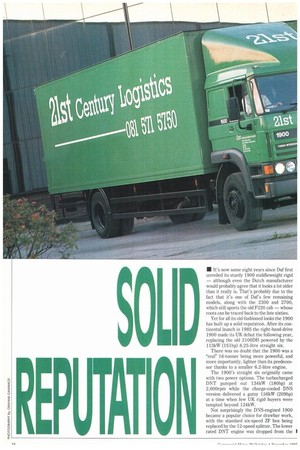
Page 32
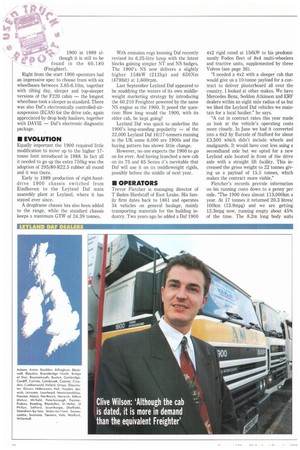
Page 33
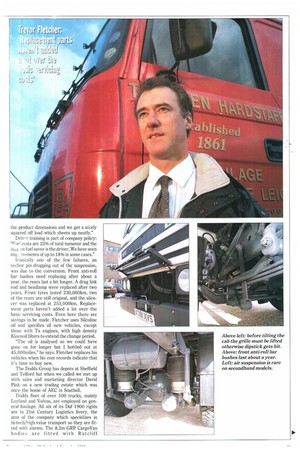
Page 34
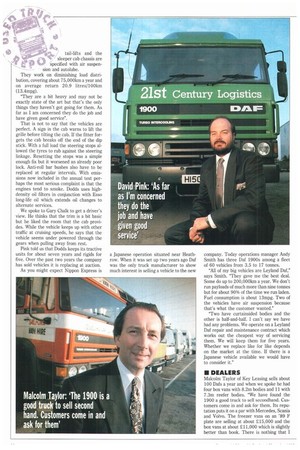
Page 35
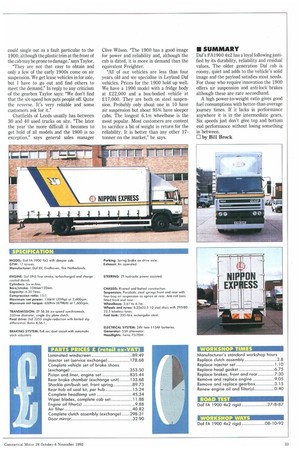
If you've noticed an error in this article please click here to report it so we can fix it.
• It's now some eight years since Daf first unveiled its sturdy 1900 middleweight rigid — although even the Dutch manufacturer would probably agree that it looks a lot older than it really is. That's probably due to the fact that it's one of Daf's few remaining models, along with the 2300 and 2700, which still sports the old F220 cab — whose roots can be traced back to the late sixties.
Yet for all its old-fashioned looks the 1900 has built up a solid reputation. After its continental launch in 1985 the right-hand-drive 1900 made its UK debut the following year, replacing the old 2100DH powered by the 113kW (151hp) 8.25-litre straight six.
There was no doubt that the 1900 was a "real" 16-tonner being more powerful, and more importantly, lighter than its predecessor thanks to a smaller 6.2-litre engine.
The 1900's straight six originally came with two power options. The turbocharged DNT pumped out 134kW (180hp) at 2,600rpm while the charge-cooled DNS version delivered a gutsy 156kW (209hp) at a time when few UK rigid buyers were tempted beyond 134kW.
Not surprisingly the DNS-engined 1900 became a popular choice for drawbar work, with the standard six-speed a box being replaced by the 12-speed splitter. The lower rated DNT engine was dropped from the I 1900 in 1989 al
el0 , though it is still to be found in the 60.180 (Freighter).
Right from the start 1900 operators had an impressive spec to choose from with six wheelbases between 3.65-6.10m, together with tilting day, sleeper and top-sleeper versions of the F220 cabin — the longest wheelbase took a sleeper as standard. There was also Daf's electronically controlled-airsuspension (ECAS) for the drive axle, again appreciated by drop body hauliers, together with DAVIE — Daf's electronic diagnostic package.
• EVOLUTION
Equally important the 1900 required little modification to move up to the higher 17tonne limit introduced in 1988. In fact all it needed to go up the extra 750kg was the adoption of 295/80-R22.5 rubber all round and it was there.
Early in 1989 production of right-handdrive 1900 chassis switched from Eindhoven to the Leyland Daf main assembly plant at Leyland, where it has stayed ever since.
A dropframe chassis has also been added to the range, while the standard chassis keeps a maximum GTW of 24.39 tonnes. With emission regs looming Daf recently revised its 6.25-litre lump with the latest blocks gaining simpler NT and NS badges. The 1900's NS now delivers a slightly higher 158kW (212hp) and 650Nm (479lbft) at 1,600rpm.
Last September Leyland Daf appeared to be muddying the waters of its own middleweight marketing strategy by introducing the 60.210 Freighter powered by the same NS engine as the 1900. It posed the question: How long would the 1900, with its older cab, be kept going?
Leyland Daf was quick to underline the 1900's long-standing popularity — of the 22,000 Leyland Daf 16/17-tormers running in the UK some 6,000 are 1900s and the buying pattern has shown little change.
However, no one expects the 1900 to go on for ever. And having launched a new cab on its 75 and 85 Series it's inevitable that Daf will use it on its middleweight rigids, possibly before the middle of next year.
• OPERATORS
Trevor Fletcher is managing director of T Baden Hardstaff of East Leake. His family firm dates back to 1861 and operates 34 vehicles on general haulage, mainly transporting materials for the building industry. Two years ago he added a Daf 1900 4x2 rigid rated at 156kW to his predominantly Foden fleet of 8x4 multi-wheelers and tractive units, supplemented by three Volvos (see page 36).
I needed a 4x2 with a sleeper cab that would give us a 10-tonne payload for a contract to deliver plasterboard all over the country. I looked at other makes. We have Mercedes Benz, Seddon Atkinson and ERF dealers within an eight mile radius of us but we liked the Leyland Daf vehicles we maintain for a local haulier." he says.
"A cut in contract rates this year made us look at the vehicle's operating costs more closely. In June we had it converted into a 6x2 by Euraxle of Stafford for about £3,500 which didn't include wheels and mudguards. It would have cost less using a secondhand axle but we opted for a new Leyland axle located in front of the drive axle with a straight lift facility. This increased the gross weight to 22 tonnes giving us a payload of 15.5 tonnes, which makes the contract more viable."
Fletcher's records provide information on his running costs down to a penny per mile. "The 1900 does almost 113,000km a year. At 17 tonnes it returned 20.3 litres/ 100Itm (13.9mpg) and we are getting 12.3mpg now, running empty about 45% of the time. The 8.2m long body suits the product dimensions and we get a nicely squared off load which sheets up neatly."
Driv-r training is part of company policy: "Fuel costs are 22% of total turnover and the
:St fuel saver is the driver. We have seen
wements of up to 18% in some cases."
Ironically one of the few failures, an anchor pin dropping out of the suspension, was due to the conversion. Front anti-roll bar bushes need replacing after about a year, the rears last a bit longer. A drag link end and headlamp were replaced after two years_ Front tyres lasted 230,000km, two of the rears are still original, and the silencer was replaced at 253,000km. Replacement parts haven't added a lot over the basic servicing costs. Even here there are savings to be made. Fletcher uses Silcoline oil and specifies all new vehicles, except those with Tx engines, with high density Kleenoil filters to extend the change period.
"The oil is analysed so we could have gone on for longer but I bottled out at 45,000miles," he says. Fletcher replaces his vehicles when his cost records indicate that it's time to buy new.
The Dodds Group has depots at Sheffield and Telford but when we called we met up with sales and marketing director David Pink on a new trading estate which was once the home of AEC in Southall.
Dodds fleet of over 100 trucks, mainly Leyland and Volvos, are employed on general haulage. All six of its Daf 1900 rigids are in 21st Century Logistics livery, the arm of the company which specializes in hi-tech/high-value transport so they are fitted with alarms. The 8.2m GRP CargoVan bodies are fitted with Ratcliff
tail-lifts and the N." sleeper cab chassis are WO so Specified with air suspen sion and autolube.
They work on diminishing load distribution, covering about 75,000km a year and on average return 20.9 litres/100km (13.4mpg).
"They are a bit heavy and may not be exactly state of the art but that's the only things they haven't got going for them. As far as I am concerned they do the job and have given good service".
That is not to say that the vehicles are perfect. A sign in the cab warns to lift the grille before tilting the cab. If the fitter forgets the cab breaks off the end of the dip stick. With a full load the steering stops allowed the tyres to rub against the steering linkage. Resetting the stops was a simple enough fix but it worsened an already poor lock. Anti-roll bar bushes also have to be replaced at regular intervals. With emissions now included in the annual test perhaps the most serious complaint is that the engines tend to smoke. Dodds uses highdensity oil filters in conjunction with Esso long-life oil which extends oil changes to alternate services.
We spoke to Gary Chalk to get a driver's view. He thinks that the trim is a bit basic but he liked the room that the cab provides. While the vehicle keeps up with other traffic at cruising speeds, he says that the vehicle seems under powered through the gears when pulling away from rest.
Pink told us that Dodds keeps its tractive units for about seven years and rigids for five. Over the past two years the company has sold vehicles it is replacing at auction.
As you might expect Nippon Express is a Japanese operation situated near Heathrow. When it was set up two years ago Daf was the only truck manufacturer to show much interest in selling a vehicle to the new company. Today operations manager Andy Smith has three Daf 1900s among a fleet of 60 vehicles from 3.5 to 17 tonnes.
"All of my big vehicles are Leyland Daf," says Smith. "They gave me the best deal. Some do up to 200,000km a year. We don't run payloads of much more than nine tonnes but for about 90% of the time we run laden. Fuel consumption is about 13mpg. Two of the vehicles have air suspension because that's what the customer wanted."
"Two have curtainsided bodies and the other is half-and-half. I can't say we have had any problems. We operate on a Leyland Daf repair and maintenance contract which works out the cheapest way of servicing them. We will keep them for five years. Whether we replace like for like depends on the market at the time. If there is a Japanese vehicle available we would have to consider it."
11 DEALERS
Malcolm Taylor of Key Leasing sells about 100 Dafs a year and when we spoke he had four box vans with 8.2m bodies and 11 with 7.3m reefer bodies. "We have found the 1900 a good truck to sell secondhand. Customers come in and ask for them. Its reputation puts it on a par with Mercedes, Scania and Volvo. The freezer vans on an '89 F plate are selling at about £15,000 and the box vans at about £11,000 which is slightly better than book. There is nothing that I could single out as a fault particular to the 1900, although the plastic trim at the front of the cab may be prone to damage." says Taylor.
"They are not that easy to obtain and only a few of the early 1900s come on air suspension. We get lease vehicles in for sale, but I have to go out and find others to meet the demand." In reply to any criticism of the gearbox Taylor says: "We don't find that the six-speed box puts people off. Quite the reverse. It's very reliable and some customers ask for it," Chatfields of Leeds usually has between 30 and 40 used trucks on site. "The later the year the more difficult it becomes to get hold of all models and the 1900 is no exception," says general sales manager Clive Wilson. "The 1900 has a good image for power and reliability and, although the cab is dated, it is more in demand than the equivalent Freighter.
"All of our vehicles are less than four years old and we specialise in Leyland Daf vehicles. Prices for the 1900 hold up well. We have a 1990 model with a fridge body at £22,000 and a box-bodied vehicle at £17,000. They are both on steel suspension. Probably only about one in 10 have air suspension but about 95% have sleeper cabs. The longest 6.1m wheelbase is the most popular, Most customers are content to sacrifice a bit of weight in return for the reliability. It is better than any other 17tanner on the market," he says,
• SUMMARY
Daf's FA1900 4x2 has a loyal following justified by its durability, reliability and residual values. The older generation Daf cab is roomy, quiet and adds to the vehicle's solid image and the payload satisfies most needs. For those who require innovation the 1900 offers air suspension and anti-lock brakes although these are rare secondhand.
A high power-to-weight ratio gives good fuel consumptions with better-than-average journey times. If it lacks in performance anywhere it is in the intermediate gears. Six speeds just don't give top and bottom end performance without losing something in between.
CI by Bill Brock
















































































